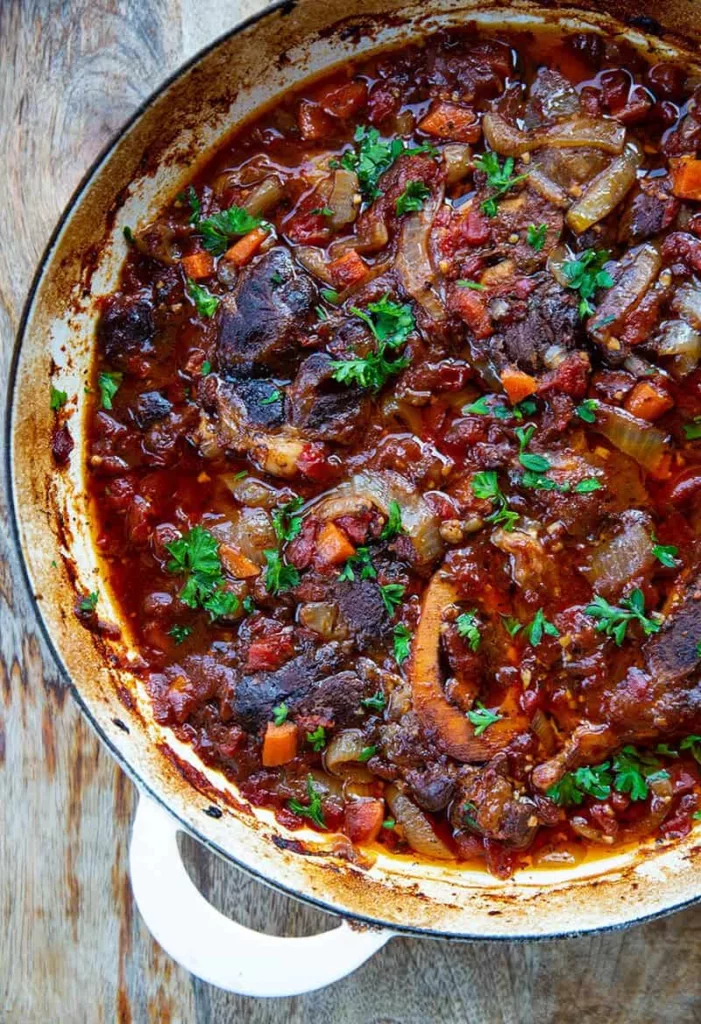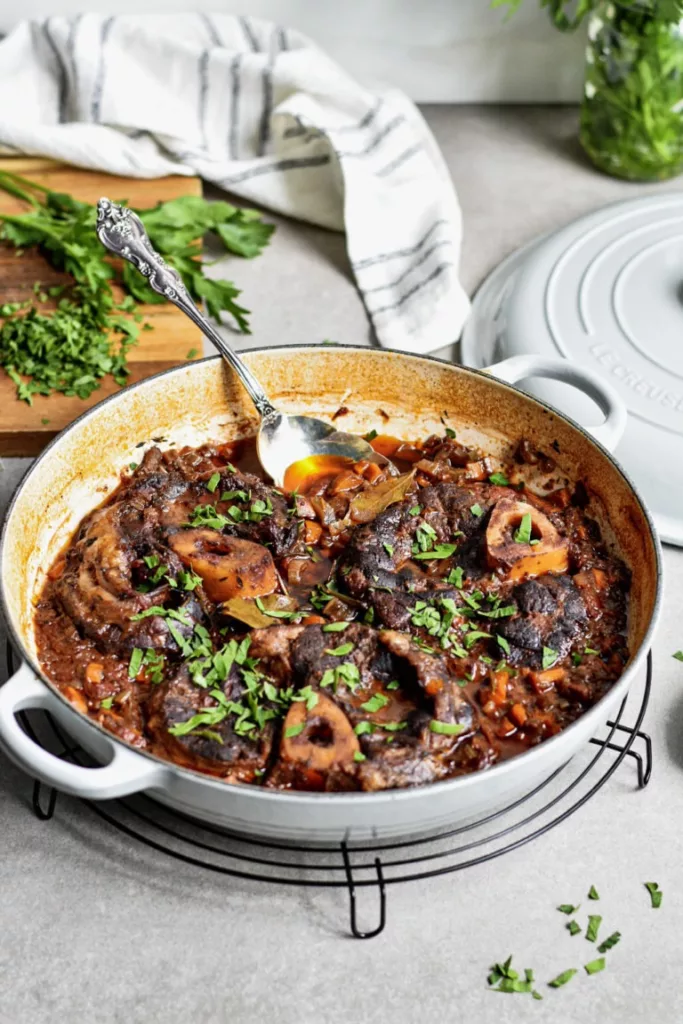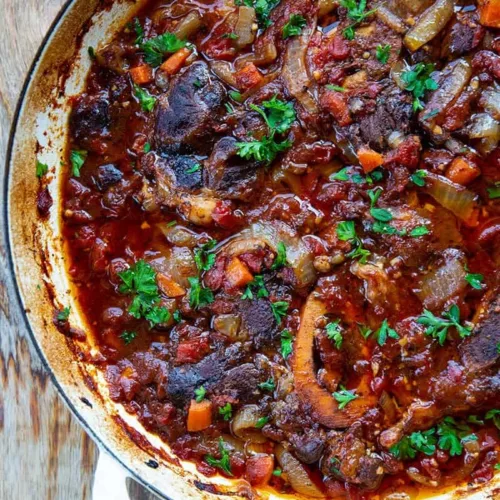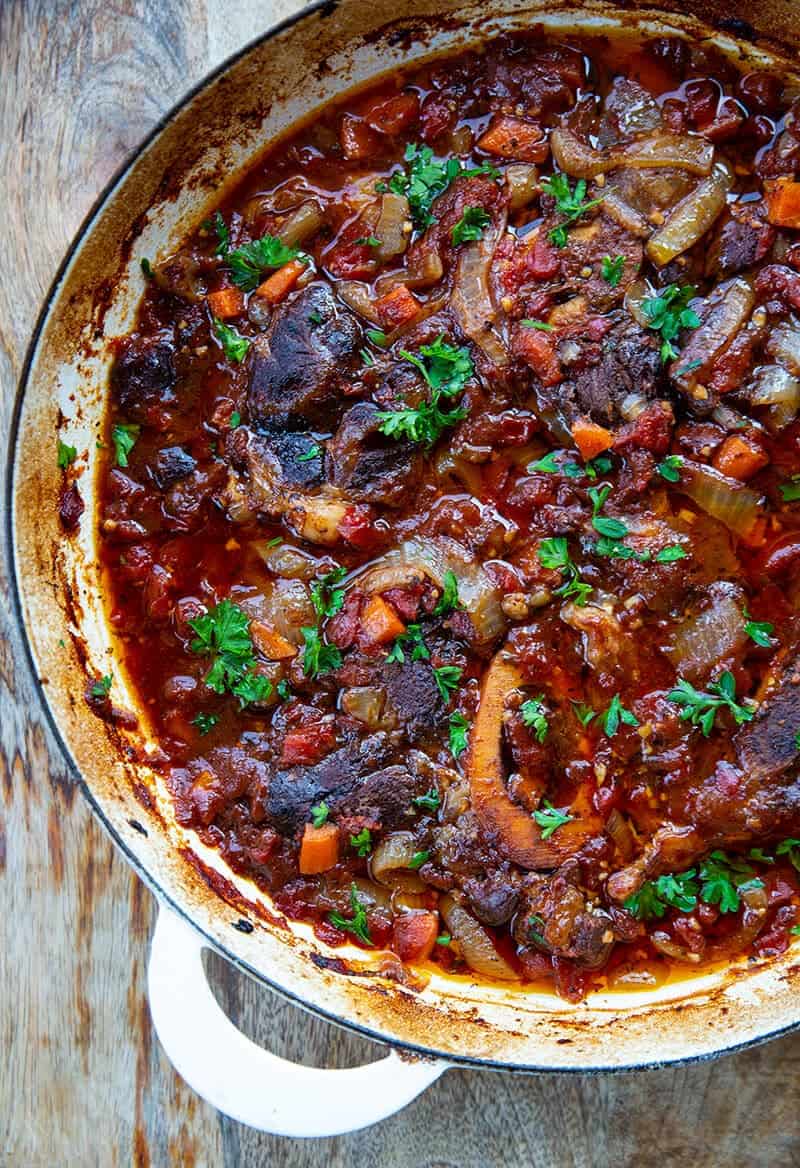The succulent flesh of a slow-cooked or Dutch oven-braised veal shank has a heartwarming quality. It’s difficult to resist assembling around the dinner table as the flavors mingle and a delightful perfume fills the air. This beef shank osso buco dish is sure to please, whether it’s being served for a formal occasion or a casual family dinner.

The secret is to use cross-cut beef shanks, which enable the taste of the bone marrow to seep into the braising liquid and produce a rich, sauce that is fork-tender perfection. Incorporate bay leaves, fresh parsley, garlic cloves, and a blend of fresh herbs to create a fragrant dish that’s ideal for hosting guests or spending time at home!
What does Osso buco mean?
The Italian term “osso buco” means “bone with a hole.” Though often cooked using veal shanks, it’s also sometimes made with pig or, in this case, beef shanks. The marrow in the middle of the bone gives the sauce richness while the meat breaks down and becomes soft while it simmers.
How should you cook beef shank?
A sturdy braiser, such as this La Creuset Dutch oven, is essential for producing dishes like Osso Buco, or decadent beef shank. The enameled cast iron is perfect for low- and slow-heating cooking since it transfers heat reliably and evenly. It also moves effortlessly from burner to oven to table.
A pressure cooker such as the Instant Pot or crock pot may be quite helpful for those who are more convenient. Because these machines can cook food at high pressure, they are excellent at producing the perfect texture and flavor. Tender, fall-off-the-bone meat that melts in your mouth is the outcome whether you choose the slower cooking method or the accelerated results of pressure cooking.

How to make decadent beef shank osso buco
Even though this recipe could simmer for a few hours, it’s quite simple to prepare. I’ll walk you through each step so you can present this sophisticated meal on the table.
- First, sear the beef shanks over medium-high heat in a heated Dutch oven or pressure cooker. This stage seals in the fluids and helps the meat form a lovely crust. When the shanks are thoroughly browned, trim out any excess fat and use a glass of red wine to deglaze the bottom of the pot, bringing all the delicious browned pieces into the sauce.
- It is now necessary to prepare the braising liquid. To make a rich broth that will accentuate the tastes of the meal, add either beef broth or chicken broth—or even a combination of the two. Add a few bay leaves and some fresh thyme sprigs to infuse the drink with wonderful aromatics. Lower the heat and stew the shanks in the aromatic broth until they are fork-tender.
- The connective tissues of the osso buco break down as it cooks, turning the meat into a soft, delicate treat. When the shanks are cooked, remove any unused fat from the sauce’s top and whisk in a little amount of flour to give it a slightly thicker consistency. This step will give the sauce an amazing texture that is ideal for spreading over the meat and any side dishes that go with it.
- This may be baked in your oven or allowed to boil for a few hours on your stovetop. The decision is entirely yours. The recommended cooking time is 2 1/2 hours, but that’s all it is. Really, what you want is for your meat to be soft and delicate.
Commonly asked questions
How to store beef shank
Should you have any leftovers, refrigerate them in an airtight container. The flavors will have further melded together the next day, improving the flavor.
How do you serve beef shank osso buco?
Serve the beef osso buco over creamy polenta for a traditional presentation that lets the sauce coat every mouthful. On the other hand, mashed potatoes or risotto alla Milanese would be just as tasty. To enliven the tastes, don’t forget to garnish with a little grated lemon zest and fresh parsley.
Is osso bucco the same as beef shank?
Yes, the terms “beef shank” and “osso buco” refer to the same piece of meat. An alternative to using cross-cut veal shanks is to use beef shanks for making the Italian dish osso buco.
The term “beef shank” describes the flesh that is removed from a cow’s leg; this usually includes the surrounding meat as well as the bone. This is a hearty and robust cut that becomes soft and develops rich tastes when cooked slowly using techniques like braising or stewing.
Thus, even though veal shanks are typically thought of when making osso buco, using beef shanks can be a tasty and more cost-effective substitute.

More Recipes You Might Like
- Lemon Chicken Meatball Soup
- Creamy Mushroom Sauce with Bacon and Thyme
- Slow Cooker Pot Roast Beef Stroganoff
- Cider Vinegar Chicken Stew
- Honey Mustard Chicken

Decadent Beef Shank Osso Buco
Ingredients
- 3 beef shanks
- 1/4 cup neutral oil
- 1/2 cup All-Purpose flour
- 2 carrots peeled and diced
- 2 celery ribs diced
- 1 yellow or sweet onion diced
- 3 garlic cloves minced
- 1 cup red wine
- 2 cups water or broth
- 2 cups canned crushed plum tomatoes
- sprig of fresh thyme
- sprig of rosemary
- 2-3 bay leaves
- fresh parsley chopped
- 2 tbsp salt divided
- freshly ground black pepper
Instructions
- Add salt and pepper to the meat shanks for seasoning. ❚
- Shake off extra flour after dredging the shanks in it.
- Grease the Dutch oven and place it over medium-high heat. Don’t overcrowd when adding the beef shanks once they are thoroughly cooked.
- Allow the steak to caramelize on both sides by browning it for three to four minutes on each side.
- The meat should be taken out of the pan and placed aside.
- Stirring continually, sauté the onion, carrots, celery, and garlic for two to three minutes over medium-high heat.
- To deglaze, add the wine and scrape away all of the brown pieces from the meat and veggies. Let the wine diminish to half.
- Stir the pan after adding the crushed tomatoes. ▚
- Add pepper and salt for seasoning.
- Return the steak shanks and the drippings from the dish to the pan. ▚
- Add the bay leaves and fresh herbs, and stir in the water or broth.
- Once the beef is tender and the sauce has decreased, cook the beef on low for two and a half hours with a cover on. You may also bake this at 350 degrees for the same amount of time.
- Take the saucepan out of the oven or burner. ❚
- Throw away the bay leaves and the stalks from the herbs.
- Top with a sprinkle of fresh parsley. ♓
- Serve with spaghetti, rice, mashed potatoes, or polenta. Have fun!
Notes
- For best recipe success, please read the blog post & notes in its entirety.
